
January 30, 2012: This sign on I-35 in Texas could have an interstate shield in its future, I-14, running west along US 190 to Fort Hood.
Embedded in the five-year highway bill recently signed into law is designation of more national high-priority corridors. One mainly follows US 190 in Texas, but if you look at a map, that highway is anything but straight. Through the same congressional subterfuge that gave us Interstate 99, the corridor in Texas will be named Interstate 14. The number is in the right place, between I-10 and I-20, and in the far far future an interstate could extend eastward to Montgomery, Alabama. There’s another designation in the law too, Interstate 11 between Las Vegas and Reno. (Of course that will never ever come to fruition, but remember who the Senate Minority Leader is.)
(By the way, do you know we have an Interstate 2 now? It’s about 47 miles long in the southernmost part of Texas, running west from Harlingen to where development peters out. It puts a big hurdle in my desire to have at least a little of every interstate west of the Mississippi, that’s for sure.)
However, there are only about 30 miles of US 190 that are interstate-grade today, between Fort Hood and I-35 in Tyler, Texas. I happened to drive it in 2012, but wouldn’t count it as interstate mileage because it wasn’t signed as an interstate then. That’s the piece that could get new shields in the next 18 months. I-14 would not be the shortest two-digit interstate (that’s I-97 between Annapolis and southern Baltimore) and it lives up to the formal name of the Dwight D. Eisenhower National System of Interstate and Defense Highways (much like I-185 in Georgia goes to not just Columbus but Fort Benning).
The agencies that are supposed to be in charge of numbering are the Special Committee on US Route Numbering and the Federal Highway Administration. Their track record recently hasn’t been the best as far as roadgeeks like myself are concerned. (North Carolina, in particular, needs some sense slapped into it.) Whether you think I-69 is pork-barrel spending gone mad or a necessary addition to our transportation system, the number is a monstrosity going where it shouldn’t and then splitting into suffixed routes southwest of Houston. The I-69 designation also was written into law as part of a highway spending bill.
The numbering committee meets during conferences of the American Association of State Highway and Transportation Officials (AASHTO), which recently elected Iowa DOT Director Paul Trombino as its president. As a perk of that office (or at least I presume it’s a perk), the AASHTO spring 2016 conference will be in Des Moines. It’s meant for transportation bigwigs in the public and private sectors, but I wondered if there would be a way to go as a private citizen… and then I saw the registration fees. Yowza.
Speaking of I-69, another long section of already existing freeway in Kentucky has been designated as I-69, and Indiana now has completed the interstate from Evansville to Bloomington. The University of Indiana in Bloomington was the last in the Big Ten not to have an interstate connection ever since State College was reached by — and here’s where the blog post finishes circling around itself — I-99.
